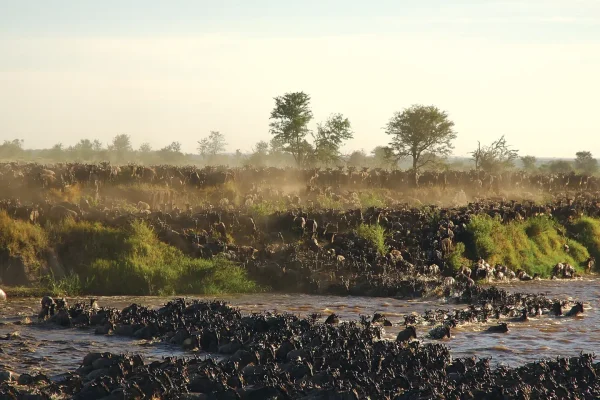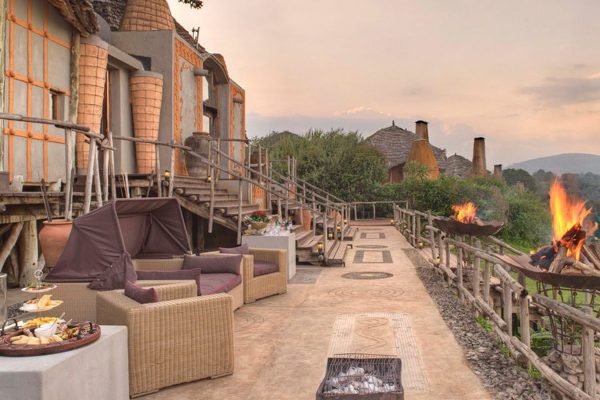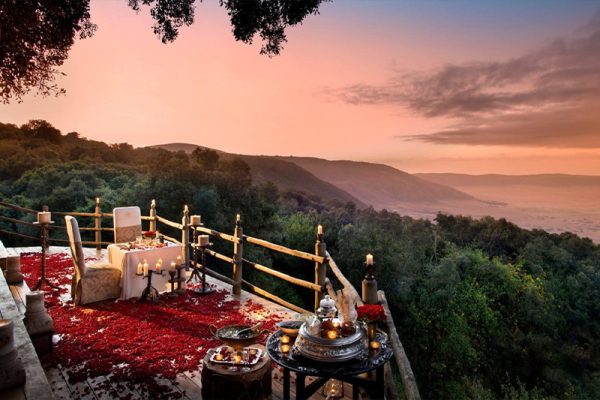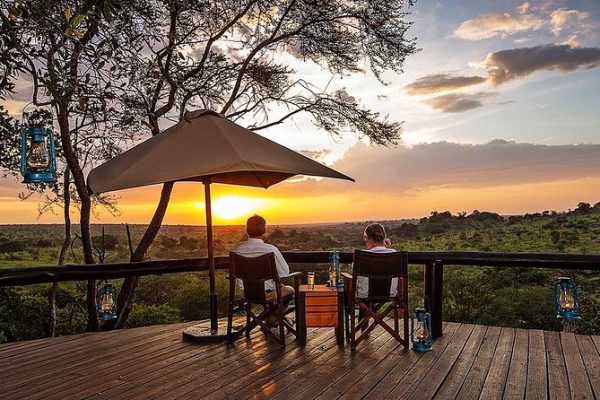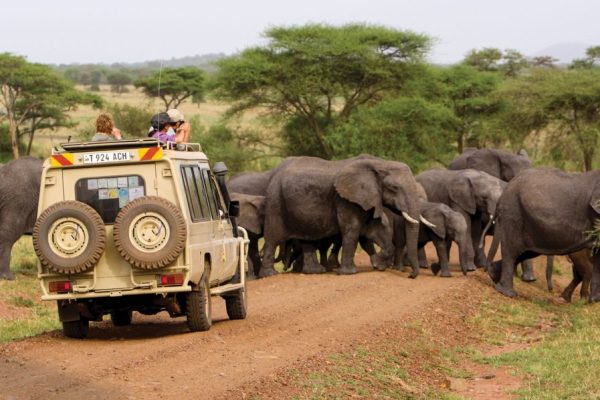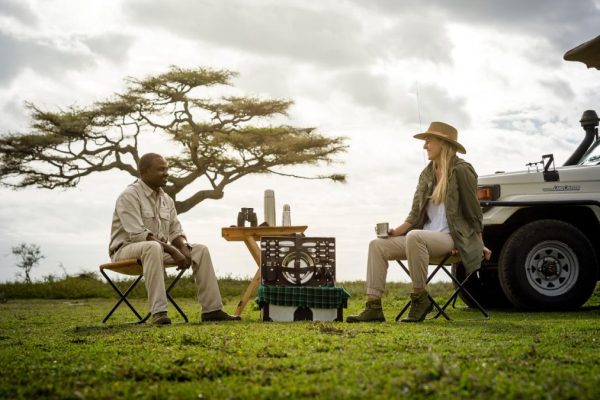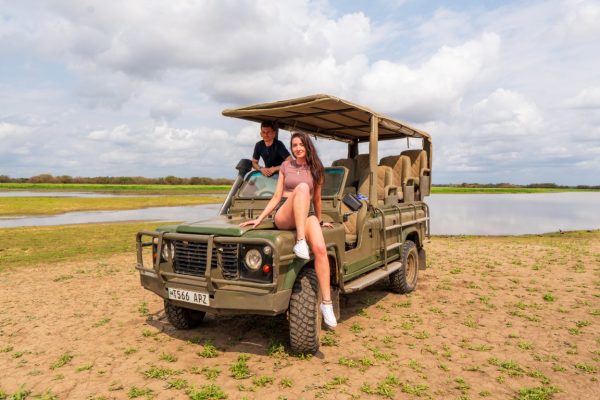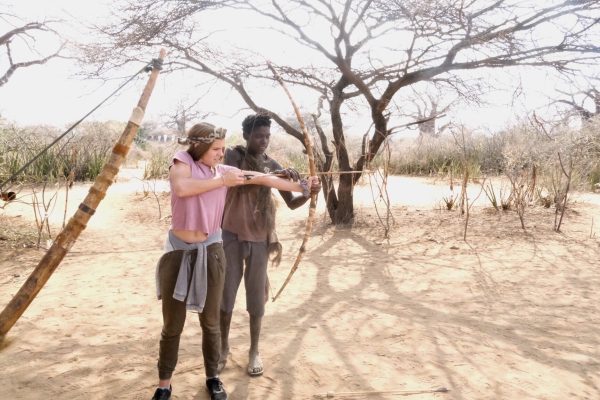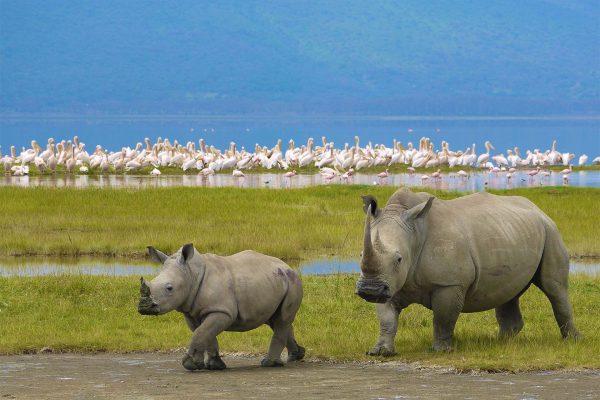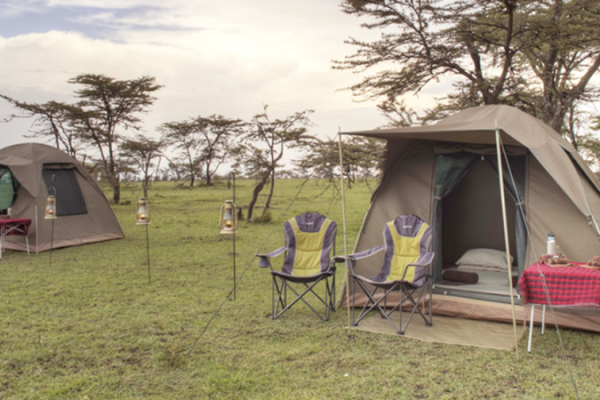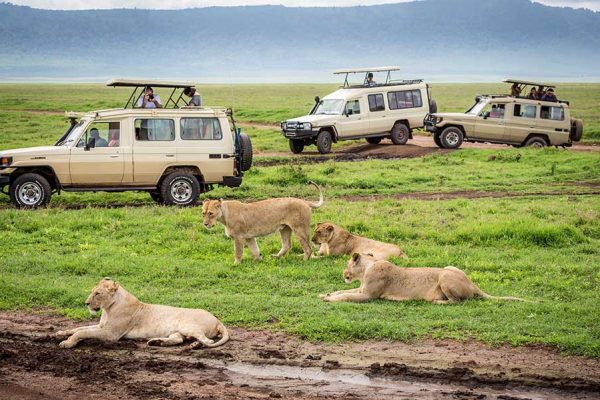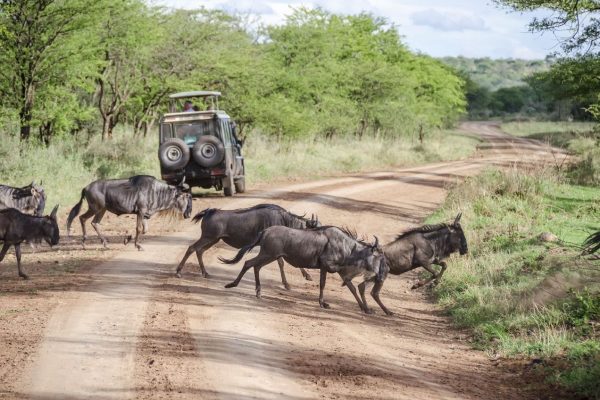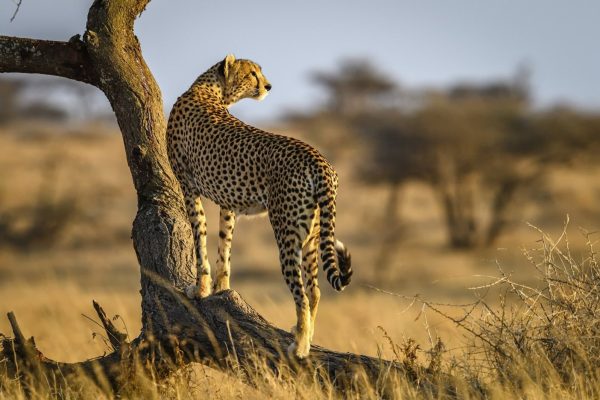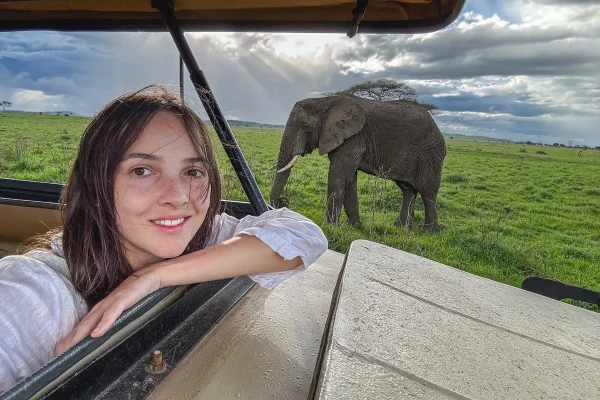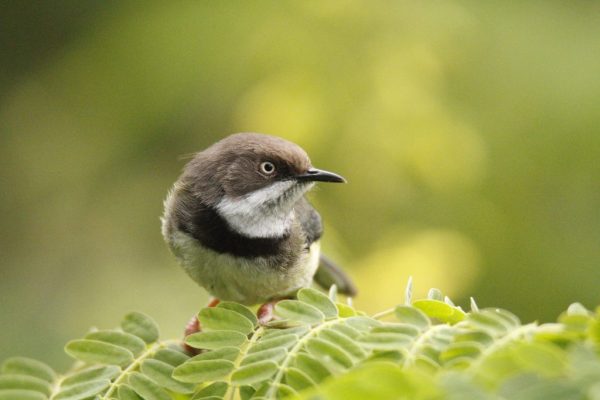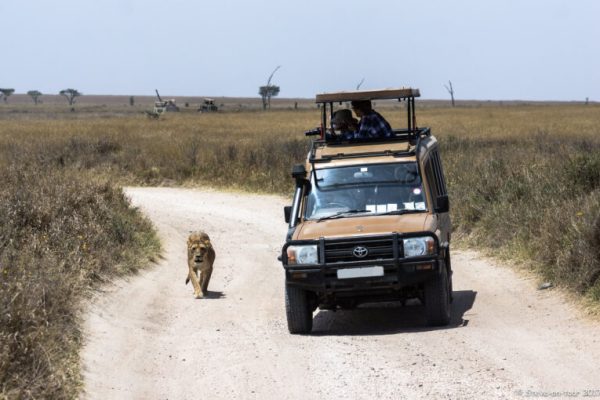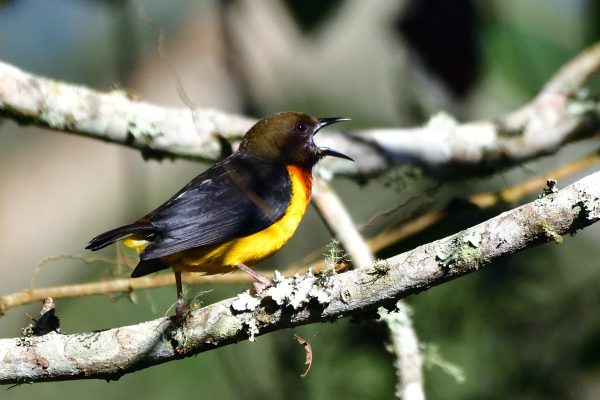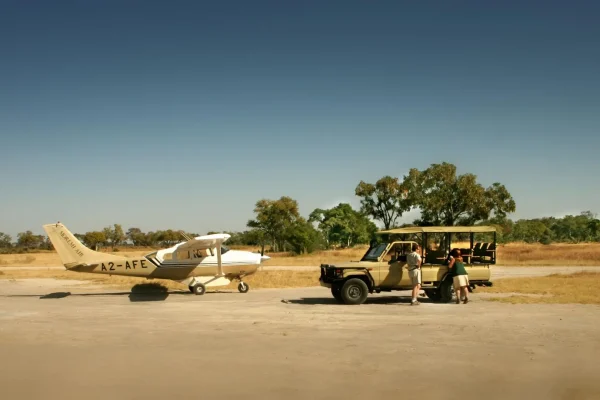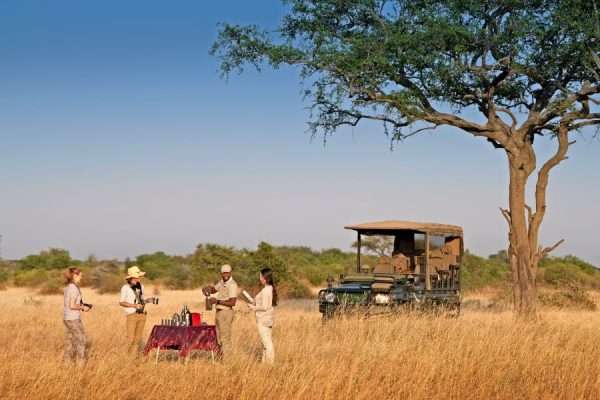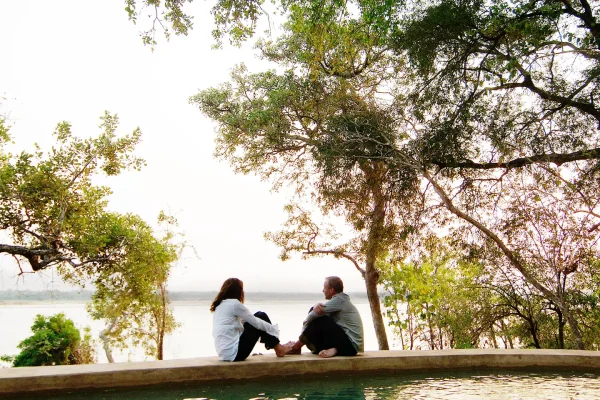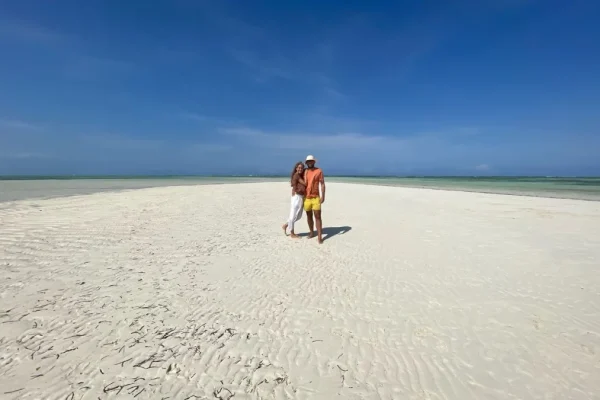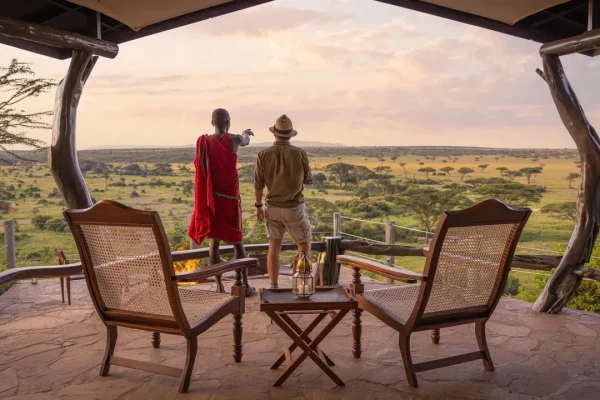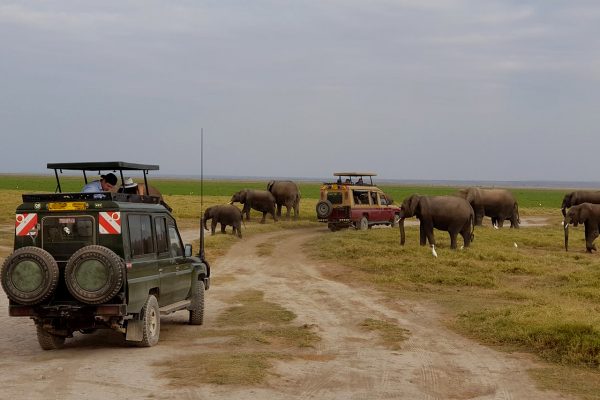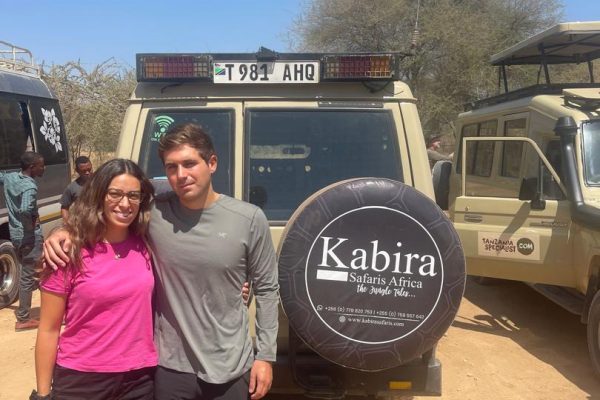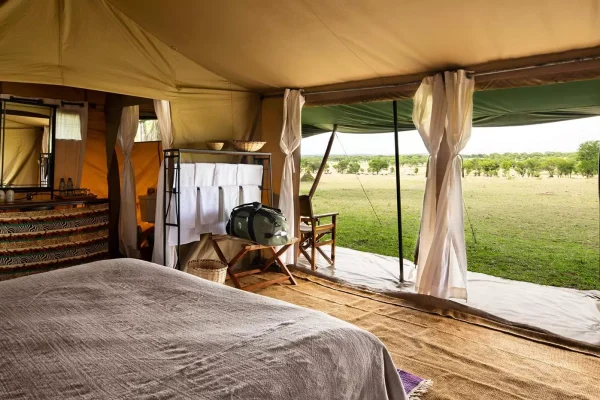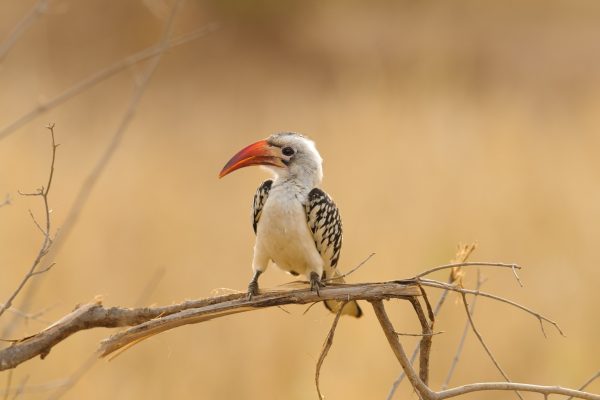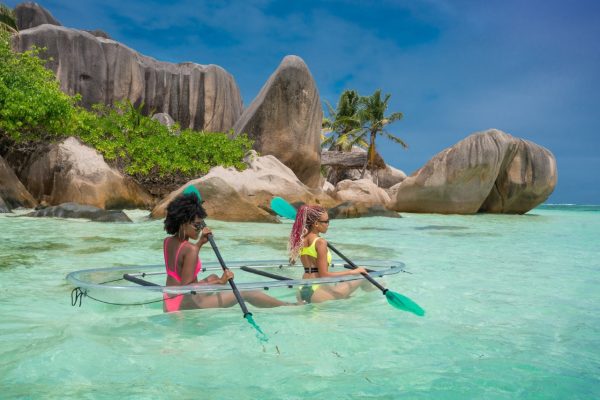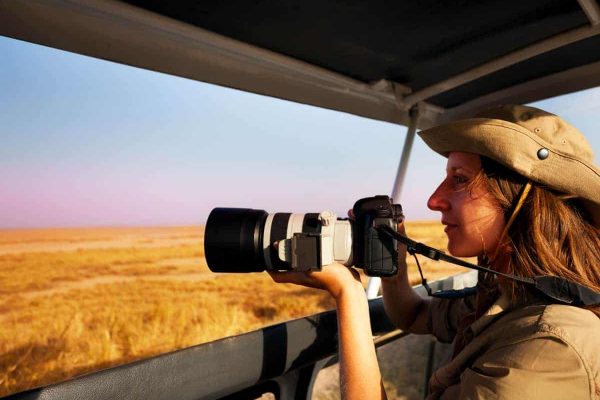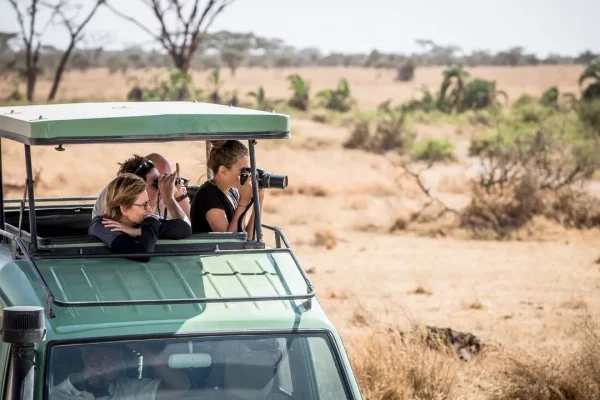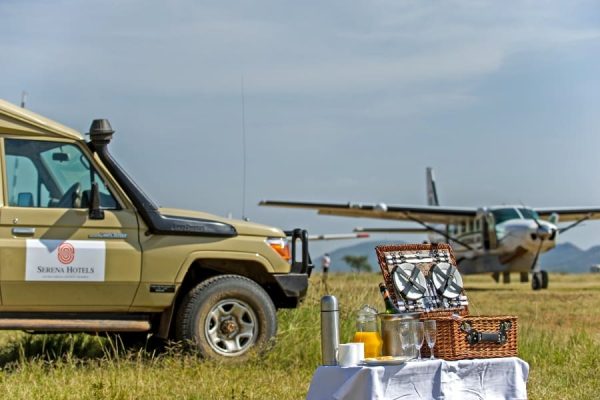The Serengeti Safaris: Luxury Serengeti Safaris Tours
On your Luxury Serengeti Safaris. “The migration through the Serengeti follows a reasonably predictable annual cycle. Best of Serengeti Safaris in Tanzania take to the Best Serengeti Safari Lodges inside and outside Serengeti National Park for the finest of Africa’s Wildlife Safaris. Luxury Serengeti Safaris will be a highlight of a visit to Tanzania.
Serengeti Lodge Safaris in The Serengeti National Park. are the finest Africa Safari Destinations. Extending over 14,763km² of undulating plains and isolated Koppies (rocky hills), The Serengeti is Tanzania’s oldest, largest, and most famous National Park in Tanzania.
The Serengeti is renowned for hosting an annual migration comprising at least two million wildebeest, plains zebra, and gazelle – the greatest spectacle of its type in Africa – but the immense plains are also home to unusually dense populations of lion, leopard, cheetah, and other predators while being possessed of a liberating sense of space best experienced on an early-morning balloon safari. Best of Serengeti Safaris will be a highlight of a visit to Tanzania.
Luxury Serengeti Safaris
Luxury Serengeti Safaris offer high-end accommodations, gourmet dining, and exclusive experiences like private game drives and guided walks, with costs often ranging from $600 to over $1,000+ per person per day.
Options include top lodges and camps such as Singita Faru Faru Lodge, the Four Seasons Safari Lodge Serengeti, and various Asilia Africa properties, often booked through tour operators or directly with the lodges. The best time to visit for wildlife viewing is during the Great Wildebeest Migration, though prices may increase during these periods.
Luxury Serengeti Safaris Tours
The Serengeti is a coveted destination for numerous travellers to East Africa, and the Wildebeest Migration is an essential spectacle for any wildlife aficionado. Regardless of whether you are a novice or an experienced traveler, the Serengeti’s diversity ensures that you will continually encounter novel experiences, irrespective of the frequency of your safari visits.
A multitude of tourists go for a Serengeti safari to commemorate significant events such as honeymoons, engagements, and birthdays. It is an excellent safari destination to pair with a beach vacation on a tropical Indian Ocean island such as Zanzibar, Mauritius, or the Seychelles.
For those seeking to maximise wildlife encounters in a single journey, we offer an extensive selection of Serengeti safaris tailored to accommodate nearly every traveler. Some concentrate only on the Serengeti and its fauna, while others incorporate this renowned national park into a broader itinerary. More economical Serengeti safari vacations consist of scheduled departure packages that frequently incorporate several days in the neighbouring Ngorongoro Crater or Kenya’s Masai Mara.
Explore our suggested Serengeti travel itineraries below or contact one of our Africa Safari Experts to customise a Serengeti itinerary that aligns with your travel preferences and budget:
Wildebeest Migration Serengeti
The Wildebeest Migration in the Serengeti is an 800-kilometer (500-mile) clockwise journey of over a million wildebeest, zebras, and gazelles, following the rains and fresh grasses across the plains of Tanzania and Kenya. It begins in the south of the Serengeti around December to April, with the crucial calving season occurring in February. The herds then move north through the Serengeti, crossing rivers and eventually entering Kenya’s Masai Mara in search of greener pastures before returning south.
Serengeti Safari Packages
The Serengeti is among Africa’s premier safari locales. The Serengeti, with 14,763 km² (5,700 mi²) of rolling plains and isolated koppies, is Tanzania’s oldest, largest, and most renowned national park. The Serengeti is celebrated for its annual migration of over 2 million wildebeest, plains zebra, and gazelle, representing the most significant phenomenon of its kind in Africa. Additionally, the vast plains support unusually high densities of lions, leopards, cheetahs, and other predators, while offering a liberating sense of space.
Serengeti Travel Advice
For your Serengeti trip, book your safari package, choose a time for the Wildebeest Migration river crossings if desired, and bring neutral-colored clothing, a wide-brimmed hat, and binoculars. Follow your guide’s instructions to stay safe and respectful of the wildlife. Get necessary vaccinations, pack antimalarial medication, and use U.S. dollar and Tanzanian Shilling for payments. Be mindful of potential crime, keep documents secure, and stay alert in tourist areas.
4 Days Tanzania Lodge Safari
The Perfect 4 Days Tanzania Lodge safari to Tarangire and Serengeti are two renowned Tanzanian national parks, offering distinct safari experiences. Tarangire is known for its high elephant population, dense vegetation, and iconic baobab trees, providing a more intimate wildlife experience with fewer tourists. A 4-day Tanzania lodge safari typically covers the Northern Circuit’s main parks, with an itinerary often including Tarangire National Park, Serengeti National Park.
5 Days Tanzania Lodge Safari
A 5-day Tanzania lodge safari typically covers the Northern Circuit parks, including Tarangire National Park, Lake Manyara National Park, Serengeti National Park, and the Ngorongoro Conservation Area. The itinerary involves game drives in a 4×4 vehicle, accommodation in lodges, and meals, with specific park visits often including Tarangire, Serengeti, and the Ngorongoro Crater. The cost varies depending on the operator, group size, and level of luxury, but it typically includes park fees, guide services, meals, and transport.
6 Days Tanzania Lodge Safari
A 6-day Tanzania lodge safari typically covers the northern circuit’s popular parks, including Tarangire National Park, Serengeti National Park, and Ngorongoro Crater, often with a visit to Lake Manyara. These packages provide a balance of wildlife viewing and comfort, using lodges or tented camps for accommodation and including transport, park fees, and meals. An example itinerary includes arrival in Arusha, followed by game drives in Tarangire, Serengeti, and Ngorongoro, with a return to Arusha on the final day.
7 Days Tanzania Lodge Safari
A 7-day Tanzania lodge safari typically includes visits to the northern safari circuit’s major parks like Serengeti, Ngorongoro Crater, Tarangire, and Lake Manyara, with stays in lodges or permanent tented camps. The itinerary often includes game drives, wildlife viewing, and airport transfers, with costs varying based on factors like the season, accommodation level, and group size.
10 Days Tanzania Luxury Safari
This 10 Days in Tanzania: A First-Timer’s Complete Itinerary is one of our amazing Luxury Tanzania Lodge Safari Packages offering a visit to the most interesting wildlife viewing destinations in Tanzania including Serengeti National Park, Ngorongoro Conservation Area, Lake Manyara National Park, and Tarangire National Park. These 4 destinations are situated in the Tanzania northern safari.
2 Day Serengeti Safari
A 2-day Serengeti safari from Arusha, Mwanza, or Nairobi is possible, most efficiently done by flying into the park to maximize time, though an overland trip is also an option. Overland trips can take 6–8 hours each way and may allow for visits to other parks, while flights offer more time for game drives. For a short, 2-day trip, a fly-in option is recommended to get the most out of the experience.
7 Day Tanzania Camping Safari
This 7-day Tanzania camping safari itinerary takes you through diverse ecosystems, offering incredible wildlife encounters and breathtaking landscapes, with a focus on the renowned Serengeti migration and the unique chimpanzee experience in Mahale Mountains National Park. Embark on a seven-day Tanzania Safari to discover the most magnificent national parks in Africa! Begin your journey in Arusha and embark on a week of unforgettable safari adventures, which will include visits to two of Africa’s Seven Natural Wonders.
10 Day Tanzania Itinerary-Northern
The 10 Days Tanzania Luxury Safari Itinerary in Northern Tanzania. Discover the magnificent parks of northern Tanzania during this 10-day luxury safari. From the little yet charming parks of Tarangire and Lake Manyara to the vast expanses of the renowned Serengeti and the impressive Ngorongoro Crater. Experience the unparalleled natural phenomenon of the Wildebeest Migration in the Serengeti and admire the breathtaking vistas of the game-abundant Ngorongoro Crater bottom.
5 Days Tanzania Camping Safari
A typical 5-day Tanzania camping safari explores northern circuit parks like Tarangire, Serengeti, Ngorongoro Crater, and Lake Manyara, starting and ending in Arusha. The itinerary often includes daily game drives and camping in designated campsites, offering a budget-friendly way to experience the country’s diverse wildlife, from Tarangire’s elephants to the Serengeti’s big cats and Ngorongoro’s dense populations.
3 Days Serengeti And Ngorongoro
This exhilarating three-day Serengeti and Ngorongoro Safari Itinerary offers the chance to experience the stunning national parks of Northern Tanzania, regarded as the premier safari location. Your program encompasses excursions to Serengeti National Park and Ngorongoro Crater. An experienced guide will operate a robust 4×4 WD jeep for your convenience. To improve your experience, complimentary.
4 Days Tanzania Camping Safari
A 4-day Tanzania camping safari typically includes visits to Tarangire National Park, the Serengeti National Park, and the Ngorongoro Crater. These safaris involve camping in unfenced public campsites and include game drives, transportation, park fees, and meals. A sample itinerary might involve arrival on Day 1, followed by game drives on Days 2 and 3 in Serengeti and Ngorongoro, with departure on Day 4.
7 Days Tanzania Wildlife Safari
A 7-day Tanzania wildlife safari typically includes visits to the Serengeti, Ngorongoro Crater, and Lake Manyara or Tarangire National Park, often with game drives in a 4×4 vehicle. A common itinerary involves arriving in Arusha and then moving between these parks for a loop, with a focus on wildlife viewing before departing on day 7.
8 Days Tanzania Camping Safari
An 8-day Tanzania camping safari typically includes visits to Tarangire National Park, Serengeti National Park, and the Ngorongoro Crater. An example itinerary involves arriving in Arusha on Day 1, spending Days 2-3 in Tarangire and Manyara, Days 4-6 in Serengeti, and then visiting the Ngorongoro Crater on Day 7 before departing on Day 8.
9 Days Tanzania Camping Safari
A 9-day Tanzania camping safari typically includes visits to Tarangire, Lake Manyara, the Serengeti, and the Ngorongoro Crater, offering diverse wildlife viewing opportunities, especially for the Great Migration. The itinerary often starts and ends in Arusha, with daily game drives and overnight stays at public or private campsites. Cultural stops, such as at Lake Eyasi to visit the Hadzabe and Datoga tribes, are sometimes included as well.
Tanzania Birding
Tanzania is a premier birding destination with over 1,388 species, offering both popular and remote birding experiences. The best time to visit is from November to April when migratory birds are present and resident species are in breeding plumage. Popular birding spots include the Serengeti and Tarangire National Parks, which are great for savanna species, while the Eastern Arc Mountains are home to endemic and range-restricted species.
Masai Mara to Serengeti
Here is a list of the best routes from Nairobi, Kenya’s capital city, or Masai Mara to Serengeti National Park. While the Masai Mara National Reserve and the Serengeti National Park are close to one another and only divided by the Tanzania–Kenya border, traveling from one side of the road to the other is more difficult than it appears on the map.
9 Days Tanzania Camping Safari
A 9-day Tanzania camping safari typically includes visits to Tarangire, Lake Manyara, the Serengeti, and the Ngorongoro Crater, offering diverse wildlife viewing opportunities, especially for the Great Migration. The itinerary often starts and ends in Arusha, with daily game drives and overnight stays at public or private campsites. Cultural stops, such as at Lake Eyasi to visit the Hadzabe and Datoga tribes, are sometimes included as well.
Tanzania Birding
Tanzania is a premier birding destination with over 1,388 species, offering both popular and remote birding experiences. The best time to visit is from November to April when migratory birds are present and resident species are in breeding plumage. Popular birding spots include the Serengeti and Tarangire National Parks, which are great for savanna species, while the Eastern Arc Mountains are home to endemic and range-restricted species.
7-Day Usambara Endemics Birding
A 7-day Usambara Endemics birding tour in Tanzania focuses on the Usambara Mountains’ unique species, often including the West Usambaras and Magamba Forest, while a full itinerary may also include other nearby sites like the South Pare Mountains for the South Pare White-eye. Such tours aim to find endemic birds like the Usambara Weaver, Usambara Akalat, Usambara Thrush, Usambara Double-collared Sunbird, African Tailorbird, and Spot-throat. Some itineraries might start in Arusha and include other locations like Tarangire or Lake Manyara for a wider variety of species.
Masai Mara Vs Serengeti Vs Kruger
The main difference is location: Kruger National Park is in South Africa, while the Serengeti and Masai Mara are in Tanzania and Kenya, respectively, and share an ecosystem. Kruger is known for the “Big 5,” self-drive safaris, diverse ecosystems, and more developed infrastructure. The Serengeti is famous for the vastness of its landscape and the Great Migration, offering a more remote and immersive experience. The Masai Mara is also a key part of the Great Migration and is ideal for seeing predator-prey interactions, offering cultural experiences and a more “compact” safari experience, according to Tour Compass.
Serengeti And Zanzibar Honeymoon
A Serengeti tour followed by a Zanzibar honeymoon combines the thrill of a wildlife safari with the relaxation of a tropical beach getaway, creating a popular and balanced honeymoon itinerary. A typical trip includes wildlife viewing in the Serengeti, potentially with optional activities like a hot air balloon safari, before flying to Zanzibar for activities like exploring Stone Town and relaxing on pristine beaches. A trip to Tanzania’s Serengeti and Zanzibar beach honeymoon combines an iconic safari experience with relaxing beach time on a tropical island.
Serengeti And Rwanda Gorilla Trek
A combined Serengeti safari and Rwanda gorilla trek is a multi-country African adventure that involves flying from Rwanda, after gorilla trekking in Volcanoes National Park, to Tanzania for wildlife viewing in the Serengeti. This trip is ideal for seeing both the mountain gorillas and the Great Migration. The best time to combine these trips is during the dry seasons (June to September and December to February) for clearer skies and easier trekking, though both activities are possible year-round.
Tanzania And Zanzibar Honeymoon
An 8-day Tanzania and Zanzibar honeymoon typically combines a safari in northern Tanzania’s national parks with a relaxing beach escape in Zanzibar. The itinerary usually starts with 3-4 days of wildlife viewing in parks like Tarangire, Serengeti, and Ngorongoro Crater, followed by a flight to Zanzibar for 3-4 days of beach relaxation, historic tours, and activities like a spice tour.
Kenya, Tanzania And Rwanda Safari
A combined safari of Kenya, Tanzania, and Rwanda offers diverse wildlife viewing, focusing on Rwanda’s primates and the “Big Five” in Kenya and Tanzania. Key highlights include gorilla trekking in Rwanda’s Volcanoes National Park, witnessing the Great Migration in Kenya’s Maasai Mara and Tanzania’s Serengeti, and exploring the Ngorongoro Crater for diverse wildlife. This multi-country trip combines primate encounters with classic savannah safaris through a mix of guided drives and trekking.
Wildebeest Migration And Gorilla Trek
The best time to combine the Wildebeest Migration and Gorilla Trekking is between July and October, when the migration’s dramatic river crossings occur in the Maasai Mara and Serengeti, and weather conditions for gorilla trekking are favorable in Uganda and Rwanda. During these months, you can arrange a safari that includes observing the large herds of wildebeest, zebras, and gazelles in East Africa, followed by trekking through the forests to see mountain gorillas.
Serengeti Safari And Zanzibar Beach
A trip combining a Serengeti safari with a Zanzibar beach holiday is a popular way to experience both wildlife and relaxation in Tanzania. The safari offers adventures like game drives to see the Big Five and the Great Wildebeest Migration, while the beach provides opportunities for water activities, relaxing on white-sand beaches, and exploring Stone Town’s culture. These trips are typically connected by a short flight from a Serengeti airstrip to Zanzibar’s airport.
Tanzania Safari And Zanzibar Beach
An 11-day Tanzania safari and Zanzibar trip combines a wildlife safari in northern parks with a relaxing beach experience on Zanzibar. A typical itinerary includes game drives in parks like the Serengeti, Tarangire, and Ngorongoro Crater, followed by a flight to Zanzibar for beach time and cultural exploration. This 11-day Tanzania safari itinerary takes you through diverse ecosystems, offering incredible wildlife encounters in the Serengeti, Ngorongoro Crater, and other renowned national parks.
Kenya And Tanzania Safari
Kenya is better for budget-conscious, first-time, or time-limited travelers due to its better infrastructure, accessibility, and potentially lower costs, while Tanzania is ideal for experienced safari-goers or those seeking a more immersive experience in vast landscapes and the Great Migration, despite higher park fees and costs. Through all the destinations, the 10 Days Kenya and Tanzania Safari Package will include arrival at Jomo Kenyatta International Airport in Nairobi and departure at Kilimanjaro Airport in Tanzania.
Tanzania And Uganda Safari
A combined Tanzania and Uganda safari offers a diverse East African wildlife experience, blending the savanna wildlife and Great Migration in Tanzania with primate encounters in Uganda. Key highlights include witnessing the Serengeti’s wildebeest and the Ngorongoro Crater’s predators in Tanzania, while Uganda provides opportunities for gorilla trekking in Bwindi Impenetrable Forest and chimpanzee tracking in Kibale Forest. It’s a journey that combines vast plains, dramatic migrations, and misty mountain rainforests.
6 Days Tanzania Camping Safari
A 6-day Tanzania camping safari typically includes game drives in Tarangire National Park, Lake Manyara National Park, Serengeti National Park, and the Ngorongoro Crater, starting and ending in Arusha. The itinerary often involves daily travel between parks, with accommodation in public campsites, and aims to provide an affordable and immersive wildlife experience. On your Six Days Tanzania camping Itinerary, you will witness the great wildebeest Mara crossing, one of the dramatic phenomena.
8 Days Tanzania Safari
An 8-day Tanzania safari typically covers the “Northern Circuit,” including Tarangire National Park, the Serengeti, and the Ngorongoro Crater, often starting and ending in Arusha. The itinerary usually includes travel days, multiple game drives in each park, and sometimes a visit to a cultural site like a Maasai village or a flight to Zanzibar for a beach experience at the end. Key highlights include seeing large elephant herds in Tarangire, the Great Migration in the Serengeti, and the diverse wildlife in the Ngorongoro Crater.
15 Days Tanzania Birding Tour
A 15-day Tanzania birding tour typically includes a combination of birding and wildlife viewing in northern Tanzania’s parks, like Tarangire, Lake Manyara, and Serengeti, along with other areas such as the West and East Usambara Mountains or the Ngorongoro Crater. Itineraries often start with arrival in Arusha, cover diverse habitats to maximize bird species, and conclude with departure from Arusha. A 15-day Tanzania birding trip typically focuses on the diverse habitats of the Northern Circuit, including the Lark Plains.
21 Days Tanzania Birding
A 21-day birding trip in Tanzania is an extended safari that can include key locations like the Serengeti, Ngorongoro Crater, Tarangire, and Arusha National Park, with potential extensions to coastal and island areas like the Usambaras and Pemba Island. Such a trip focuses on spotting a high number of species, including endemic birds like the yellow barbet and near-endemic species like the grey-chested helmet shrike. It often involves a mix of diverse habitats, from savannas to montane forests, and may also include significant wildlife viewing.
Kenya And Seychelles Honeymoon
Embarking on a safari is among life’s most exhilarating adventures; nonetheless, such exhilaration can result in considerable fatigue. Considering this, we have developed an itinerary that guarantees an exhilarating safari experience followed by complete relaxation, comprising a 13-night combination of Kenya and the Seychelles. Your journey begins with an overnight stay at the renowned Giraffe Manor, where you may enjoy breakfast or afternoon tea in the company of giraffes. Subsequently, you will start on a week-long safari to observe rhinos, tree-climbing lions, and other wildlife.
Kenya And Tanzania Photographic Safari
A two-week Kenya and Tanzania photographic safari typically includes iconic parks like the Masai Mara, Serengeti, and Ngorongoro Crater, with a possible extension to Tarangire National Park or Zanzibar. These trips are designed to maximize wildlife sightings and can be customized to include activities like hot-air balloon rides, with costs varying by style (luxury, mid-range, budget) and including transport, accommodation, and park fees. In between safaris, learn about local customs on a visit to a Maasai community and share a meal with a family in the vibrant Mto Wa Mbu village.
Rwanda, Serengeti And Zanzibar Honeymoon
A Rwanda, Serengeti, and Zanzibar honeymoon is a trip that combines the thrill of seeing mountain gorillas in Rwanda, wildlife safaris in Tanzania’s Serengeti, and relaxation on the beaches of Zanzibar. This adventure-packed honeymoon typically includes gorilla trekking in Volcanoes National Park, game drives in Serengeti National Park, and relaxing on Zanzibar’s beaches with activities like dhow cruises or snorkeling. Booking well in advance is recommended, especially for limited gorilla permits.
Serengeti And Zanzibar Beach
A Serengeti and Zanzibar honeymoon combines the adventure of a safari in the Serengeti with the relaxation of a beach vacation in Zanzibar, creating a balanced romantic getaway. A typical itinerary includes flying from the mainland to the Serengeti for game drives, followed by a flight to Zanzibar for beach time, cultural exploration, and relaxation on the coast. The best time to go is during the dry season from June to October, which is also the high season for safari.
Serengeti vs Masai Mara Safari
The choice between a Serengeti and Masai Mara safari depends on preferences: the Serengeti is better for its vast size, diverse landscapes, and sense of adventure, while the Masai Mara is ideal for wildlife density and dramatic river crossings, often at a lower cost. The Serengeti provides a more secluded experience with more diverse lodging options, whereas the Mara has more budget-friendly options and is smaller and easier to navigate.
Serengeti Safari from
To plan a Serengeti safari from the USA, Canada, Australia, UK, or South Africa, you can book with international or local tour operators who specialize in African travel, arrange a fly-in safari from a nearby international airport like Kilimanjaro (JRO), or book a multi-country safari that includes the Serengeti. Travelers should also be aware of the best times to go, such as October through July for the wildebeest migration, and the park fees which are charged per person, per day.
When is the Best time to see the Great Migration in Serengeti
On your Serengeti Safaris. “The migration through the Serengeti follows a reasonably predictable annual cycle, but there is also variation from one year to the next, dependent mainly on the rainfall.
If you are looking to see a horizonless column of braying wildebeest on the move, aim for the Western Corridor in late May to June, when the migration heads towards the south bank of the Grumeti River before crossing it, usually in early July.
More reliable for river crossings is the far north of the park over August to October when herds of several hundred or a few thousand make the treacherous crossing from one side of the Mara River to the other with logic-defying regularity.
Over December to April, the wildebeest disperse into the southeast Serengeti, which is the most accessible part of the park from Arusha, but might still be seen in herds that stretch from one horizon to the other.
These southeastern plains are the main wildebeest calving grounds, with peak calving season usually centered on February, a phenomenon that attracts high predator concentrations.”
What animals can I expect to see on Serengeti Safari?
“The Serengeti is great when it comes to both variety and volume of wildlife. Over the course of a typical Serengeti safari, you can expect to see lions on a daily basis, and with luck, you will also encounter a host of other carnivores including leopard (most common around Seronera), cheetah, spotted hyena, black-backed jackal, golden jackal, and bat-eared fox. You might also be lucky enough to see secretive nocturnal creatures such as civet, serval, genet, and African wildcat.
Also certain to be seen on Serengeti tours are elephant, buffalo, giraffe, hippo, plains zebra, wildebeest, Thomson’s gazelle, Grant’s gazelle, impala, Coke’s hartebeest, and warthog. The localized patas monkey and black-and-white colobus are both residents in the Western Corridor. The black rhino is scarce and more likely to be seen in Ngorongoro Crater. Around 550 bird species have been recorded, among them the endemic grey-throated spurfowl, Fischer’s lovebird, Rufous-tailed Weaver, Usambiro barbet, and grey-crested helmet-shrike. The open plains are good for terrestrial giants such as ostrich, kori bustard, secretary bird, and southern ground hornbill.”
What Country is the Serengeti?
Tanzania: Serengeti National Park. The National Park, and wildlife refuge on the Serengeti Plain in north-central Tanzania. It is partly adjacent to the Kenya border and is northwest of the adjoining Ngorongoro Conservation Area.
How long is the drive to the Serengeti?
On your Serengeti Safari in Tanzania. “Coming directly from Arusha, it is around 300km to the park headquarters at Seronera.
The first half of this drive follows the same surfaced road that runs past Lake Manyara to the main eastern entrance of the Ngorongoro Conservation Area (NCA). The second follows a rough and dusty corrugated track around the Ngorongoro Crater rim and western plains of the NCA. Allow at least six hours for the full drive, and ideally a full day. Note, however, that most Serengeti tours include overnight stops at Lake Manyara and/or Ngorongoro Crater, which helps to break up the trip.”
What condition are the roads in within the Serengeti?
“By any sensible international standards, the roads are terrible. It’s not a problem when you are on a relaxed game drive, but it can be tough going on longer drives between lodges and camps. If this sounds daunting, or you have a vulnerable back, think about booking a Serengeti Safari Package that includes flights into the park and between lodges and camps.”
What lodges or camps would you recommend on Serengeti Safaris?
“If your budget runs to it, there are some superb exclusive small lodges and tented camps scattered around the Serengeti Safari Park. I tend to favor places with a more remote crowd-beating location. Sanctuary Kusini Camp, set among massive boulders in the far south, offers superb wildlife-viewing during February and March; the semi-permanent Dunia Camp near Moru Koppies offers excellent wildlife viewing all year, peaking from December to March; the super-stylish &Beyond Grumeti Serengeti Tented Camp is easily the pick of the lodges in the western corridor, where wildlife activity peaks from May to July; and there’s not much to separate Lamai Serengeti and Sayari Camp, which are the two most exclusive properties in the far north, and ideally placed to catch wildebeest river crossings from August to October. Of the more mid-range options, Ndutu Safari Lodge, a low-key, family-owned set-up overlooking the eponymous seasonal lake, is great value and offers superb predator viewing from December to April.”
What is Serengeti famous for?
The Serengeti is famed for its annual wildebeest migration, when some 8 million hooves cross the open plains, as more than 1,500,000 wildebeest, 200,000 zebra, and 300,000 Thomson’s gazelle join the trek for fresh grazing. Predators follow the migration and sightings of big cats hunting is particularly exciting. Serengeti is one of the world’s oldest ecosystems.
Serengeti National Park is one of the only fewer places where you can witness the unaltered natural animal migration in the world. Large herds of grazers that move in pursuit of fresh pastures and water for their survival have made tourists describe it as the greatest wildlife sighting on earth. The large mammal grazers with over one million wildebeest, thousands of zebras and gazelles, move through the Serengeti annually in search of food and breeding grounds.
Is Serengeti Safe for tourists
Serengeti National Park is a premier safari destination in Africa, renowned for its diverse species and quintessential African landscapes. The park provides exceptional animal observation year-round, with the big migration taking place from July to November, representing one of the most extraordinary wildlife experiences around. It is evident that Serengeti is the premier safari destination for both novices and seasoned safari enthusiasts.
For numerous travellers intending to visit the Serengeti, personal security is paramount, as demonstrated by the common inquiry, “Is the Serengeti a safe destination?”
Serengeti National Park is an exceptionally secure area to visit. The park is safeguarded by properly trained Park Rangers and wildlife Wardens. Here are several reasons why Serengeti is among the safest parks to visit for a safari in Tanzania.
How Many Days do You Need in Serengeti?
You need a minimum of 4 days to safari the Serengeti, which allows for enough time to see a variety of wildlife and key attractions. However, a longer stay of 5 to 7 days is highly recommended to get a more comprehensive experience, especially if you are a first-time visitor, as the park is very large. Staying longer will allow for more relaxed viewing and the opportunity to explore different areas.
Minimum to recommended stay
- Minimum 4 days: This is considered the minimum for a well-rounded experience, as it allows for several game drives and a good chance of seeing the Big Five (lion, leopard, elephant, buffalo, and rhino).
- 5 to 7 days: This is highly recommended to allow for a more relaxed pace and to increase your chances of seeing a greater variety of animals and landscapes, particularly if this is your first safari. A longer trip also allows for a better chance of seeing specific events like river crossings during the migration.
Can Kilimanjaro Be Seen From the Serengeti?
No, you cannot see Kilimanjaro from the Serengeti because they are too far apart, with Kilimanjaro over 150 miles away. You can only see Kilimanjaro on an exceptionally clear day from a very high vantage point, but it is not a typical view from the Serengeti itself. The best place to see Kilimanjaro with animals in the foreground is Amboseli National Park in Kenya.
For one thing, Kilimanjaro doesn’t rise above the Serengeti. You can’t even see it from the Serengeti unless you get in a hot air balloon and take a telescope: they’re about 300 kilometers from each other. Kilimanjaro rises above the Tsavo (see picture). And Mount Olympus definitely doesn’t rise above the Serengeti.
- Distance: Kilimanjaro is located over 150 miles from the closest part of the Serengeti National Park.
Weather dependency: Even on rare, extremely clear days, the view is unlikely unless you are at an elevated position. - Visibility: The curvature of the Earth, plus intervening hills and valleys, blocks the view.
- Alternative: For classic photos of Kilimanjaro with wildlife, visit Amboseli National Park in Kenya, which is famous for having elephants with Kilimanjaro in the background on clear days.
Serengeti Safari Cost
A Serengeti safari costs anywhere from $2,500 to $7,500+ per person for a one-week trip, depending on the level of luxury. Budget safaris can be as low as $350–$450 per person per day, while mid-range tours are approximately $550–$700 per day, and luxury options start around $700 per day and can exceed $1,000 per day. Factors like accommodation type, travel dates (especially during peak season or migration), and the length of your trip significantly impact the final price.
Cost by safari level
Budget:
- Daily cost: $350–$450 per person
- 5-day trip: $750–$1,500 per person
Mid-Range:
- Daily cost: $550–$700 per person
- 7-day trip: $2,500–$3,000 per person (based on Tanzanian tours)
Luxury:
- Daily cost: $800+ per person, potentially reaching $1,000+
- 7-day trip: $3,000–$4,500 per person (based on Tanzanian tours)
Is Kenya or Tanzania Safari Better?
Kenya and Tanzania safaris are renowned for their abundance of renowned parks and are primarily visited for large game. Kenya’s Masai Mara and Amboseli reserves can be seamlessly integrated with Tanzania’s Serengeti and Ngorongoro Crater on safari excursions. The most compelling justification for merging these two locations is the wildebeest migration. Beginning in the southern Serengeti, the migration then proceeds to the Masai Mara via the central and western Serengeti. By integrating Kenya and Tanzania, one will be able to observe the mega-herds in action and experience the most pristine game viewing in Africa, separate from the main event.
So in general, Tanzania is more affordable while Kenya has a better travel infrastructure. … Kenya has the larger tourism infrastructure and has more lodges to accommodate globetrotters heading on an African safari, so the cost of a safari in Kenya will likely be less than one in Tanzania.

